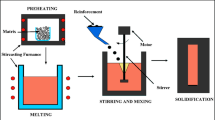Abstract
In order to optimize the processing of composite materials, the importance of digital methods in materials science is steadily increasing. In this study, two approaches were used for composite materials processing. First, for the winding of H2 storage vessels using towpregs, Bayesian optimization (BO) was used as a tool to find optimal process conditions within specified parameter limits. The applied algorithm can efficiently maximize selected target values within existing parameter limits. In this case, the goal was to achieve a maximum towpreg width of a winding standard of ¼” (6.35 mm) with a fibre volume content between 55–60 vol.%. Although this maximum couldn’t be achieved within the specified parameter limits, the BO resulted in a steady reduction of the standard deviation and thus a significant increase in process quality. In the second part of this study, an in-situ monitoring tool for a fibre spreading process was developed. Fibre spreading of low-cost but mechanically weak Heavy Tows has the potential to be used in the future production of H2 storage vessels, especially for the highly cost-effective automotive market. To gain deeper insights into the spreading process itself, a sufficient in-line monitoring tool is needed to observe and analyse the spreading behaviour of the given fibres. Using a camera setup and a developed Python tool, a method has been developed to observe the spreading process of the fibres in depth. This opens the possibility for further in-depth parameter studies on the spreading behaviour and the use of Heavy Tows in automotive applications.
Access this chapter
Tax calculation will be finalised at checkout
Purchases are for personal use only
Similar content being viewed by others
References
Züttel, A.: Hydrogen storage methods. Naturwissenschaften 91(4), 157–172 (2004). https://doi.org/10.1007/s00114-004-0516-x
Pandita, S., et al.: Clean wet-filament winding – Part 1: design concept and simulations. J. Compos. Mater. 47(3), 379–390 (Feb.2013). https://doi.org/10.1177/0021998312440474
Walker, G.: “Hydrogen storage technologies,” in Solid-State Hydrogen Storage, pp. 3–17. Elsevier, (2008). https://doi.org/10.1533/9781845694944.1.3
Lohse-Busch, H. et al.: “Report # ANL/ESD-18/12 Technology Assessment of a Fuel Cell Vehicle: 2017 Toyota Mirai,” US DOE -Energy Syst. Div., (2017) www.anl.gov
Ayakda, H., Ozan, S.: Aydiin, “HYDROGEN STORAGE TECHNOLOGIES” (2018) https://doi.org/10.1533/9781845694944.1.3
Shahriari, B., Swersky, K., Wang, Z., Adams, R.P., de Freitas, N.: Taking the Human Out of the Loop: A Review of Bayesian Optimization. Proc. IEEE 104(1), 148–175 (Jan.2016). https://doi.org/10.1109/JPROC.2015.2494218
Agnihotri, A., Batra, N.: “Exploring Bayesian Optimization”. https://distill.pub/2020/bayesian-optimization/
Li, C., et al.: Rapid Bayesian optimisation for synthesis of short polymer fibre materials. Sci. Rep. 7(1), 5683 (Jul.2017). https://doi.org/10.1038/s41598-017-05723-0
Albuquerque, H., Rodrigo, Q., Rothenhäusler, F., Ruckdäschel, H.: “Designing formulations of bio-based, multi-component epoxy resin systems via machine learning”, pp. 1–15. Submitt. Publisher
Nunna, S., Blanchard, P., Buckmaster, D., Davis, S., Naebe, M.: Development of a cost model for the production of carbon fibres. Heliyon 5(10), e02698 (Oct.2019). https://doi.org/10.1016/j.heliyon.2019.e02698
Ennis, B. et al.: “Optimized Carbon Fibre Composites in Wind Turbine Blade Design,” Sandia Rep., no. November, (2019) https://www.energy.gov/sites/default/files/2019/12/f69/SAND2019-14173-Optimized.pdf
Friedrich, K., Almajid, A.A.: Manufacturing Aspects of Advanced Polymer Composites for Automotive Applications. Appl. Compos. Mater. 20(2), 107–128 (Apr.2013). https://doi.org/10.1007/s10443-012-9258-7
Huang, C., et al.: Exploration relation between interlaminar shear properties of thin-ply laminates under short-beam bending and meso-structures. J. Compos. Mater. 52(17), 2375–2386 (Jul.2018). https://doi.org/10.1177/0021998317745586
Cugnoni, J., et al.: Towards aerospace grade thin-ply composites: Effect of ply thickness, fibre, matrix and interlayer toughening on strength and damage tolerance. Compos. Sci. Technol. 168, 467–477 (2018). https://doi.org/10.1016/j.compscitech.2018.08.037
Tonejc, M., Steiner, H., Fauster, E., Konstantopoulos, S., Schledjewski, R.: “A STUDY ON GEOMETRICAL PARAMETERS INFLUENCING THE MECHANICAL SPREADING OF FIBRE BUNDLES,” in 20th International Conference on Composite Materials, p. 10 (2015)
Vossen, C., Rene, G.: “Schlussbericht zu IGF-Vorhaben Nr. 18713 N Auto-Tow – Automatische Regulierung und Homogenisierung der Fasereigenschsaften von Hochmodulfasergarnen,” Aachen, (2018)
Gizik, D.: “Untersuchung der Verwendung von Heavy Tow Carbonfasern für Strukturbauteile in der Luft- und Raumfahrt,” Universität Stuttgart, (2018) https://www.dr.hut-verlag.de/978-3-8439-3911-9.html
Otsu, N.: A Threshold Selection Method from Gray-Level Histograms. IEEE Trans. Syst. Man. Cybern. 9(1), 62–66 (Jan.1979). https://doi.org/10.1109/TSMC.1979.4310076
Funding
The Bayesian optimization approach was funded in the project “CryoFuselage” in the BayLu25 program under guidance of German Aerospace Center (DLR). Grants were given by the Regierung of Oberbayern with the Bavarian Ministry of Economic affairs, Regional Development and Energy (StmWi) with grant number LABAY108A.
The in-situ monitoring tool development for fibre spreading was funded in the project “InLineCon” in the LuFo VI-1 program under the guidance of German Aerospace Center (DLR). Grants were given by the Federal Ministry for Economic Affairs and Climate Action (BMWK) with grant number 20E1903B.
Author information
Authors and Affiliations
Corresponding author
Editor information
Editors and Affiliations
Rights and permissions
Copyright information
© 2023 The Author(s), under exclusive license to Springer Nature Switzerland AG
About this paper
Cite this paper
Schönl, F., Hübner, F., Luik, M., Thomas, J., de Albuquerque, R., Ruckdäschel, H. (2023). Digital Approaches for Optimization of Composite Processing: Bayesian Optimization for Impregnation and Fibre Spreading In-Situ Monitoring. In: Rieser, J., Endress, F., Horoschenkoff, A., Höfer, P., Dickhut, T., Zimmermann, M. (eds) Proceedings of the Munich Symposium on Lightweight Design 2022. MSLD MSLD MSLD 2022 2022 2022. Springer Vieweg, Cham. https://doi.org/10.1007/978-3-031-33758-1_5
Download citation
DOI: https://doi.org/10.1007/978-3-031-33758-1_5
Published:
Publisher Name: Springer Vieweg, Cham
Print ISBN: 978-3-031-33757-4
Online ISBN: 978-3-031-33758-1
eBook Packages: EngineeringEngineering (R0)




